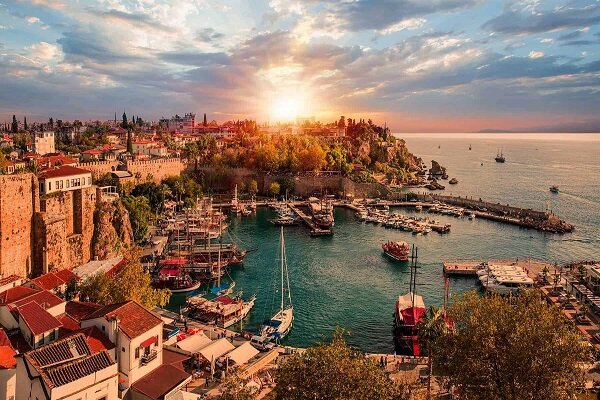Water -oriented and water economy of coastal productive cities

reports Mehr reporter , human use of the seas, especially in the economic interests we obtain, has recently been changed under the name of a blue economy. Hussein Shirzad, an agricultural development analyst, wrote in a dedicated note for Mehr that the concept of blue economy is integrally related to biodiversity, and biodiversity is the foundation of the “ecosystem services” that humans receive from nature.
“Blue Economy” is a popularity that is increasingly popular in modern marine and oceanic management. According to the World Bank’s official definition, the water economy is an economic sector based on sustainable use of ocean resources for economic growth, improvement of livelihoods and ocean ecosystem health. The blue economy focuses on the use of ocean resources in a responsible and sustainable manner, while recognizing the economic, social and environmental importance of marine environment. The term includes all economic activities related to oceans, seas and beaches such as fishing, aquaculture, marine transportation and logistics, coastal tourism and energy renewable as well as maritime laws and policies , Financial and investment, and marine technology.
The European Commission uses the term “water growth” to refer to the long-term sustainable growth strategy for various sectors related to maritime environment. The concept of blue economy was first introduced by Gunter Pauli, a Belgian economist, in the book Blue Economics, 2 years, 2 innovations and 2 million jobs. In this book, first published in the year 5, Pauli suggested that industrial processes should change to overcome problems in the environment. This is applied by the transfer of rare and costly energy sources to simpler and cleaner technologies.
, however, the World Bank of the Blue Economy as one of the healthy environmental uses of marine resources aimed at encouraging economic growth, prosperity and preservation of marine ecosystems as well as livelihoods Defines.
Economy Changing Approach
Anyway, the future of the economy is changing color, and this is thanks to the blue economy, now a circular economy focuses on strengthening our seas and oceans. /p>
for centuries that humans have relied on coastal resources, however, current population growth and increased access to coastal resources through Digitalized has led to a review of traditional exploitation strategies more productive than coastal cities. The recent global move towards developing national water economy strategies shows more focus on coastal resources to address a wide range of “basic water growth industries”. The need for sustainable development of coastal cities and future exploitation of emerging coastal resources is a political and environmental complexity. The first conference on “Sustainable Blue Economy” was held in November 2 in Nairobi, Kenya, to bring together a wide range of actors, from political and commercial leaders to the United Nations and other interdisciplinary organizations, scientific experts and civil society members. And give a clear explanation.
Humans have been exploiting marine ecosystems for a long time and more efficient use of marine resources to combat climate change and reduces pressure on natural resources for food production aid It will do. Industrial changes that have accelerated since the mid -twentieth century have allowed coastal countries to expand their territories and wealth through sea and exploitation of marine resources around the world.
Oceanic 2 % advantage
on a large scale, the oceans cover 5 % of the surface and have many social, environmental and economic benefits. They regulate the Earth’s climate, the vital food source and genetic diversity.
According to the latest Blue Economy Report, maritime transportation is the spine of the World Trade, and more than 5 % of the world trade uses marine routes and traditional parts of the water economy. They create 2 million direct jobs and more than € 5 billion in turn. The ocean’s economic activities are estimated at $ 1.5 trillion a year, and water growth is expected to continue at a faster rate than at least in the next few decades from US $ 5 trillion by year 2; In addition, oceans have a wide range of positive effects on the environment, such as oxygen production and greenhouse gases, and about 5 % of the world’s fishermen live in developing countries in coastal cities, which are the main source of food and fishing income. Therefore, the blue economy is a term used to describe a wide range of approaches and development priorities in the oceans and coastal areas.
, in the meantime, a number of distinct and sometimes contradictory discourses have emerged about the water economy that are distinguished by prioritizing different development goals. This note presents a wide range of interpretations of water economy, governance strategies, and executive approaches, emphasizing the construction of coastal productive cities. The term “blue economy” is a relatively new and influential concept that first appeared before the United Nations Convention on Sustainable Development in Year 2, UNCSD or Ray and +1 Conference. It is green and pursues the same overall goal of improving human well -being and social equality along with reducing environmental dangers and deficiencies.
Ocean blue economy as “new development spaces” P>
almost 2 % of the world’s population lives in a mile ocean, but all humans depend on it; Today, more than 5 million citizens live in coastal cities or in one of Europe’s numerous islands, and in Europe, the water economy is a kind of lifestyle that coexists with the ocean, uses marine resources in the sea, and maintains a sustainable relationship with the ocean. .
more than 5 % of the world’s population live near coastal areas, more than 2 billion people use the oceans for their livelihoods, and 2 % of world trade with world trade The use of the seas is done. With the growth of capitalism and agricultural commodity, neoliberalized territorial nature, now the broad narrative of water-based economy or base water in the “ocean-marine” territory It has come and since the beginning of the 21st century, the concept of “blue economy” has become increasingly popular with “the creation of managed spaces .
The water economy conceptualizes the oceans as “development spaces”. The blue economy has expanded the development discourse with the help of coastal productive cities to encompass the sea. Important technology neoliberalism is the funding of the basic water economy, that is, the willingness of financial markets to dominate and for financial organizations to dictate the conditions involved in ocean products and the increasing role of transactions Financing in water -based economy processes or global dominance over the manufacturing and service industries of the maritime economy by the financial sector; These cases are presented under the titles of the Blue Economics Business Model by Gunter Pauli in the Blue Economics Book of Report to the Rome Club in Year 2. He defined the blue economy as a sustainable commercial model with life in harmony with nature.
World Bank defines “the water economy” as “sustainable use of ocean resources for economic growth, improvement of livelihoods and jobs, while maintaining ocean ecosystem health” . The 14th goal of SDG is also related to the 14th Sustainable Development goal, which aims to protect “underwater life”, which includes sustainable protection and use of oceans, seas and marine resources for development.
Oceanic bed and World Food Security
oceans, seas and coastal areas help food security and poverty eradication. The international community believes the water economy, three economic axes, “countering the global water crisis; The economy covers the innovative energy development and the development of the sea -based economy. For example, shipping and tourism, marine aquaculture (an emerging approach to fish farming), tidal energy energy, extraction of sea beds and water biotechnology, breeding mussels, bacteria and algae and offshore wind energy throughout day by day. The world has become more popular and, according to the Outshore Wind Outlook 2 report by the International Energy Agency (IEA), the offshore wind force has more than 5 times the global power supply.
Due to high marine biodiversity and genetic diversity that indicates, the potential to spread in marine biotechnology, pharmaceuticals, cage farms or marine aquaculture In land, shrimp farms, the potential of seafood, oil-gas and chemical production are high.
The value of the ocean economy worldwide has been around $ 1.5 trillion a year, making it the seventh largest economy in the world. It is due to doubled by the year to $ 2 trillion. The total value of oceanic assets (natural capital) is estimated at $ 2 trillion.


